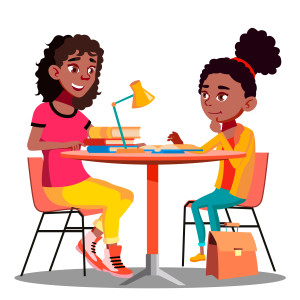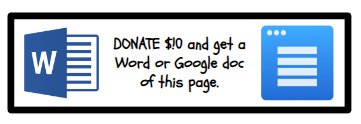


Reading Strategy Prompts
This page has reading strategy prompts to use as you teach each strategy. By using these prompts, you are promoting ACTIVE reading.
Please also check out my reading strategy objectives and comprehension strategies pages.
Check out this GREAT link, too:
Comprehension Questions for Leveled Texts
Reading Strategy Prompts for Fiction
-
What does the title mean?
-
What is happening in the part you are reading now?
-
Tell me about a strategy you used and how it helped you understand what was happening or how it helped you understand a word.
-
Would you recommend this book? To whom? Why?
-
What scene or image has stuck in your brain? Why is that scene significant?
-
What genre is this? How do you know?
-
Do you think this story could happen? Explain.
-
Which character is most like you? Why? (Use traits.)
-
Which character do you like the least? Why? (Use traits.)
-
How does the character change in the story?
-
How is this book like others you have read?
-
Would you enjoy living in the time/setting of the story? Explain.
- Is humor used in the story? Describe.
-
Where did you feel sad, worried, frightened, surprised, or envious in the story?
-
What part is your favorite? Why?
-
Did you find any interesting, well-chosen words? What were they?
-
Tell the student to preselect a passage to read aloud that gives evidence of predicting, inferring, visualizing, making connections, determining importance, descriptive language, or a key focus of recent instruction for the next meeting,
Reading Strategy Prompts for Nonfiction
- Tell me 2 facts you learned about the topic.
- What is the most memorable idea you learned?
- Describe the author’s writing style.
- What questions do you now have?
- What would you change about the book? Why?
- How would you find more information on the same topic?
- Tell me some important words in the text and what they mean.
- What is your interest in this topic?
- What are the ways the information is presented?
- What parts were hard to understand?
- Find an example of a fact in the book. Find an example of an opinion.
- If you were to write a follow-up to this book, what part of this book would you like to research more in-depth?
- Tell me what the different text features show you.
- What section did you want to read first?
- Are there any professions related to this topic? How might the information in this book be helpful to people in those professions?
- Biographies: What were the major struggles the individual faced? What character traits do you admire most about this person?
- Tell the student to preselect a passage to read aloud for the next meeting that gives evidence of predicting, inferring, visualizing, making connections, determining importance, descriptive language, or a key focus of recent instruction.

Reading Strategy Prompts by Reading Strategy
Concepts About Print ~ For PreK-Beginning Grade 1
- Where do you start reading?
- Put your finger on the first word.
- Which way are you going?
- Can you find the title?
One-To-One Matching/Early Reading Behaviors
- Point to the words and read.
- Do the words match?
- Were there the right amount words on the line to match what you said?
- Can you find _______? (Say a known or new word.)
Predicting/Previewing Prompts
- What made you come up with that prediction?
- How have your ideas changed?
- What evidence either confirmed your prediction or made you change your prediction?
- What do you think might happen next?
- What information from the text did you use to predict?
- Can you make your predictions more specific?
- I like the way you used specific details for evidence.
Detecting & Correcting Errors / Monitoring for Understanding Prompts
- Something wasn’t quite right. Can you find your error?
- What do you know that might help?
- I noticed you looked at the picture to help you read that word. Good job!
- You looked carefully at the word while you pointed to be sure your voice matched! Good for you!
- How did you know that word was_____?
- I liked how you solved that word!
- I noticed you stopped for a moment. Were you thinking about the story when you fixed that part?
- For a word read incorrectly ~ It might be that… If you look again and think, could it be anything else?
- Try that again and think about what would make sense.
- You said ______. What’s wrong? Did that make sense?
- How could the pictures help you?
- When ______ didn’t sound right, you went back to fix it. Good for you!
- That looks like the word, but does that make sense?
- Why did you stop?
- What information do you remember?
- Did the passage make sense?
- Did a word or phrase stump you?
- Reread that and see if you remember more.
- Look for a character’s name, a specific place, etc., to find what to reread.
- Have you previewed the chapter?
- What do you already know about this topic, author, or genre?
- You checked that your reading made sense.
- You read the material aloud as if you understood it.
- You checked several ways to make sure you had the right word.
- When ______ didn’t sound right, you went back to fix it.
- You reread that part to check that word. Did it work?
- I noticed you were thinking about the story as you were reading. Good thinking!
- Show me where you fixed that problem.
- How did you figure it out? What did you notice?
- Why did you do that?
- You said ______. Then you said ______. Why?
- How did you know what the word was?
Problem-Solving New Words
- Is there another word that might work here?
- Look at the beginning. . .ending.
- What do you know that might help you?
- That was almost right. Try that again.
- What good reader strategy could you try here?
- Are there any little words in this word? (chunks)
- What parts (chunks) of the word do you know?
- Reread and get your mouth ready to say the word.
- What is another word that might fit/make sense here?
- Look at the root word/prefix/suffix.
- Read ahead to figure out the meaning of the word.
Expanding Meaning ~ (Quick generic prompts.)
BEFORE READING
- Nonfiction: what 3 questions do you think will be answered?
- Based on the title and pictures, what predictions can you make?
DURING READING
- Has your prediction changed? How/Why?
- What questions do you have?
- Tell me what the nonfiction text features mean.
- How are the pictures helping you?
- What does the story remind you of?
- What is the main idea of the story?
- Can you recall some specific details?
- Tell me about what you are reading.
AFTER READING
- Retell the story.
- Fiction: What did the author teach you?
- Nonfiction: What was the most important thing that you learned?
- What was the most important event, and why?
- What was your favorite part, and why?
- What connections did you make?
- Was your prediction confirmed?
- What reading strategies did you use?

Fluency Prompts
- Put the words together so it sounds like talking.
- Did that sound like the way we talk?
- Make your voice go down when you see the period.
- Make your voice go up when you see the question mark.
- Take a short breath when you see the comma.
- Show feelings/emotions when you see the exclamation point. Use emphasis.
- Make it sound like the characters are talking.
Making Connections Prompts
- How does the story make you feel?
- Have you ever had similar experiences?
- Does the book remind you of another book, or does a character remind you of someone in your life?
- How are the characters, setting, and problems connected to your life or other stories you’ve read?
- What does the story make you wonder about?
- What surprised you?
- How are you like one of the characters?
- How is the family similar to your family?
- Have you read another book by this author?
- What does this remind you of?
- I liked the way you connected your life to the story.
Visualizing Prompts
- Based on the illustrations, what is this book about?
- What do you notice from the illustrations?
- What did you visualize or picture?
- Did you get a clearer picture in your mind?
- What do the illustrations reveal about the setting/time period?
- How could the pictures help you?
- Tell me what you saw when you read this part.
- How did the character walk? Dress? What do they look like?
- Can you find parts in the story that help you see what a place or character is like?
- What story details helped you create a mental image?
- Where did you have trouble making mental pictures?
- How would the effect of the illustrations change if the illustrator used black and white instead?
- What impact does the choice of color have on you?
- What details do you find intriguing?
Questioning Prompts
- Where did you find the answer to that question?
- Were all your questions answered in the text, or do you still have unanswered questions?
- How will you get the answers?
- What do you already know that might help you?
- What will happen next?
- How will the character solve their problem?
- What have you learned that will help you understand a character? Decision? Conflict?
- What did you learn from the picture? Diagram? Chart?
- Did you read the caption?
- I liked how you raised a question and then read on to explore the answer.
- Can you show me a part of the text where you had a question?
- Can you show me a part where you were confused? What was confusing about it?
Reading Strategy Prompts
Inferring Prompts
- What is the author’s message?
- What is the story really about?
- Do you think the title is appropriate for the story?
- What does the story mean to you?
- Why did the author write the story?
- When the character said, “__________,” what is meant?
- What did you learn from the character’s words on this page?
- What do the character’s inner thoughts show you about them?
- Can you infer what the character might do based on this event?
- Think of 3 decisions a character made and explain what the decisions taught you about the character.
- What specific adjectives or phrases describe the character’s behavior?
- How are these characters alike? Different?
- What effect resulted from that event? Decision? Conflict?
- What is the big idea of the story?
- Can you show me a place in the text where you found yourself inferring?
- What predictions are you inferring?
Summarizing/ Synthesizing /Evaluating Prompts
- Does your summary include only the main ideas and important parts?
- Tell me about what you’ve read.
- What is the main idea?
- Can you provide some details?
- Did that make sense?
- Are you retelling or summarizing?
- Choose 2 or 3 key events to summarize.
- Explain the main events in your own words.
- What is the purpose of the chapter?
- What can you find in the text to help you set a purpose?
- Can you separate the facts from the conclusions you made in your summary?
- Give several effects of the event.
- Can you show how these 2 written summaries are alike and different?
- How do you feel about what you just read?
- Do you agree or disagree with it?
- Are you learning what you wanted to know?
- How good a job has the author done?
- What do you think about the author’s style?
- Can you show me a place in the story where your thinking changed? How did your thinking change?
- Do you have new ideas or information?
Distinguishing Important Information
- What is the story or piece mostly about?
- Can you tell me about some of the important ideas that struck you?
- Are there any important themes that you noticed?
- What is the most important thing to remember about this story/topic?
 The following can be CUT INTO STRIPS and given to students to take notes as they read, addressing the reading strategies.
The following can be CUT INTO STRIPS and given to students to take notes as they read, addressing the reading strategies.
What is a strategy? A strategy is a tool stored in memory that can help one comprehend.
Grades 3 and Up ~ Independent Reading Journal ~ What Good Readers Do!
Preview Text: Previewing the text gives us a rough idea of what the text is about. Read the title, author, back cover, and inside book jacket. Flip through and look at pictures, length, and text setup. Skim, scan. What do you already know about this topic, author, or genre? Is this an appropriate book for your reading level? Set a reading purpose.
- My initial impression is. . .
- My reason for reading this is. . .
**********
Predicting/Inferring: Predicting/Inferring makes our reading interesting! We can figure out what is coming next!
- My “before reading” prediction is:
- Text clues I used about (character’s mood, season, year, setting. . .) made me infer:
- My background knowledge helped me understand. . .
- My prediction was confirmed or changed when. . .
**********
Connections: Connections keep us interested in our reading! We think about ourselves and what we already know.
- Text to Self:
- Text to Text:
- Text to World:
- I know the feeling. . .
- If I were. . .
- I’m not sure why. . .
**********
Visualizing: Visualizing helps us make a movie in our minds, making the text more interesting and memorable. Sketching out a confusing part is also helpful for comprehension.
- Here is a sketch from page ___:
**********
Questioning: Questioning helps us remember what we read. It is fun to make questions for our friends to answer, and we read more carefully to develop the best questions!
- I wonder. . .
- Before Reading Questions:
- During Reading Questions:
- After Reading Questions:
- I began to think of it.
- I don’t understand. . .
Are my questions “thick” or literal, and can answers be found in the book? Be sure to think of “thick” questions ~ the big ideas in the book! What is the theme? What is the lesson?
**********
Detecting & Correcting Errors /Monitoring For Understanding: Monitoring is what we do to figure out tricky words or ideas to make sense of our reading. We use context clues to figure out the meanings of difficult words. We look for chunks in words to help sound out unfamiliar words. When the reading no longer makes sense, we slowly reread, slowly.
- I was confused on page ___:
- A word I didn’t know was:
- So, to fix up my confusion, I…
**********
Summarizing/Synthesizing/Evaluating: Summarizing helps us track what is read. Synthesizing helps us consider what we will take away from the reading; good readers reflect on and share what is read. Finally, evaluating has us judge the text.
- The main idea of the chapter is:
- The main events (in order) are:
- Listen to my retelling of the entire chapter.
- The theme or lesson is:
- I would tell a friend this important item from the reading:
- My overall reaction to the text is:
- I noticed. . .
- My opinion of the text and author’s style is:
- I agree/disagree with the characters’ actions:
- I love the way. . .
- I can’t believe. . .
- I realized. . .
- I was surprised. . .
- I think. . .
**********
Distinguishing Important Information: Good readers decide what is important to remember and what is irrelevant to the overall understanding of the text.
- The story is mainly about. . .
- An important idea that struck me is . . .
- An important theme I noticed is . . .
- The most important thing to remember about this is . . .
**********
Nonfiction Text: Using nonfiction text features helps aid in our comprehension.
- Nonfiction text features I used are:
- I skimmed this area to review important ideas:
Copyright 02/17/2013
Edited on 03/17/2024
Copyscape alerts me to duplicate content. Please respect my work.

![]()
